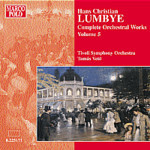
Orchestral Works, Vol. 5 (incls The Sleigh Ride, Galop & Memories from Vienna)
 $25.00
Out of Stock
$25.00
Out of Stock6+ weeks add to cart
LUMBYE
Orchestral Works, Vol. 5 (incls The Sleigh Ride, Galop & Memories from Vienna)
Tivoli Symphony Orchestra / Tamas Veto (conductor)
[ Marco Polo / CD ]
Release Date: Thursday 27 April 2006
This item is currently out of stock. It may take 6 or more weeks to obtain from when you place your order as this is a specialist product.
"The present conductor, Tamas Veto, guides his players through these charming and tuneful miniatures with considerable skill."
www.classicstoday.com
"The complete orchestral works of Hans Christian Lumbye (1810-74) are the subject of a continuing survey for Marco Polo, which reaches Volume 5 with this release. Fittingly, these recordings of 'the Danish Johann Strauss' are being made in the hall in which Lumbye himself directed performances of his dance music, the famous Tivoli Gardens Hall, whose symphony orchestra is itself the direct descendant of 'Det Lumbyeske Selskab', the orchestra of the Lumbye Society. The present conductor, Tamas Veto, guides his players through these charming and tuneful miniatures with considerable skill, but often with shrewdly gauged restraint as well, and the music is thus substantially elevated from its expected salonesque stature. Lumbye's 1845 waltz Memories from Vienna sounds especially dignified as a consequence... Further highlights of this nicely engineered disc include the orchestral fantasy In the Dusk (good horn playing here) and the Fountain Waltz, a regular favorite among Lumbye's audiences. The solo trumpet of today's Tivoli Orchestra gives an agile display in the Salute Gallop, though the most ingenious piece here is the Telegraph Gallop, a reciprocal exchange between two orchestras in which the antiphonally 'telegraphed' dialogue is clearly reproduced by the recording."
- www.classicstoday.com (Michael Jameson)7th June, 2001
Hans Christian Lumbye, today the internationally best known and most popular Danish composer of dances of the nineteenth century, was born in Copenhagen on 2nd May 1810. While he was still a child his family moved to the provinces, since his father, a military official, was posted first to Jutland and later to Odense, the birthplace of Hans Christian's later world-famous namesake, the fairy-tale writer Hans Christian Andersen.
In Odense Lumbye had his first real musical training and at the age of fourteen he succeeded in becoming a trumpeter in the local regimental band. The next year he received his diploma as a trained trumpeter, and at nineteen he returned to his birthplace Copenhagen, where he was employed as a trumpeter in 1829 in the Royal Horse Guard. In the 1830s, besides holding this musical post, Lumbye was a busy musician in the Copenhagen Stadsmusikantorkester or City Orchestra, and his earliest preserved dance compositions come from these years. In 1840 Lumbye put together his own orchestra. The inspiration to take this step had come after he had attended a series of concerts given in Copenhagen by a musical society from Steiermark in Austria, where Johann Strauss's and Joseph Lanner's new dance tunes were heard for the first time in Scandinavia.
With his own first Concert à la Strauss at the fashionable Raus Hotel in Copenhagen (the later Hôtel d'Angleterre) on 4th February 1840, Lumbye definitively began his lifelong activity as Denmark's and Scandinavia's undisputed leading dance composer. Three years later, when the now world-famous amusement park Tivoli opened its gates in Copenhagen, Lumbye acquired the final, permanent setting for his long and prolific composing and conducting career as the leader of the concert hall's orchestra. For this orchestra he composed some seven hundred dances over the next thirty years, first and foremost polkas, waltzes and galops – the last of these genres almost became synonymous with his name. But with his numerous orchestral fantasias, too, and more than 25 ballet-divertissements, Lumbye demonstrated his true mastery.
In the best of his works his orchestrations have a distinctive, lyrical, almost pristine Copenhagen sound that differs from the Vienna composers' more hot-blooded orchestral tone. Lumbye often has the violins accompanied by limpid flute sounds, while Johann Strauss, for example, liked to have the melody lines of the strings accompanied by instruments with a fuller sound like the oboe and clarinet. Lumbye also created a brighter and lighter orchestral sound than the Vienna composers thanks to his use of glockenspiel, triangle and brass.
A long series of tours abroad to Hamburg, Berlin, Vienna, Paris, St Petersburg and Stockholm brought Lumbye international recognition and fame, but he never abandoned his post in the amusement park, where his jovial figure remained a popular ingredient in Copenhagen's musical life until his death on 20th March, 1874.
H.C. Lumbye's importance in the nineteenth century for the creation of a broad, popular musical culture in Northern Europe can hardly be overestimated, but his greatest importance perhaps lies in the fact that his innumerable dance tunes have up to our own day preserved their special freshness and artistic integrity.
Tracks:
Regards to the Ticket-Holders of Tivoli
In the Dusk, Fantasy
The Sleigh Ride, Galop
Salute March of King Frederik VII
Marie Elisabeth Polka
Caroline Polka Mazurka
Artist Carnival Locomotive Galop
Hesperus, "Klange"
Telegraph Galop
Salute Galop
Fountain Waltz
Jenny Polka
Memories from Vienna
The Night Before New Year's Day



